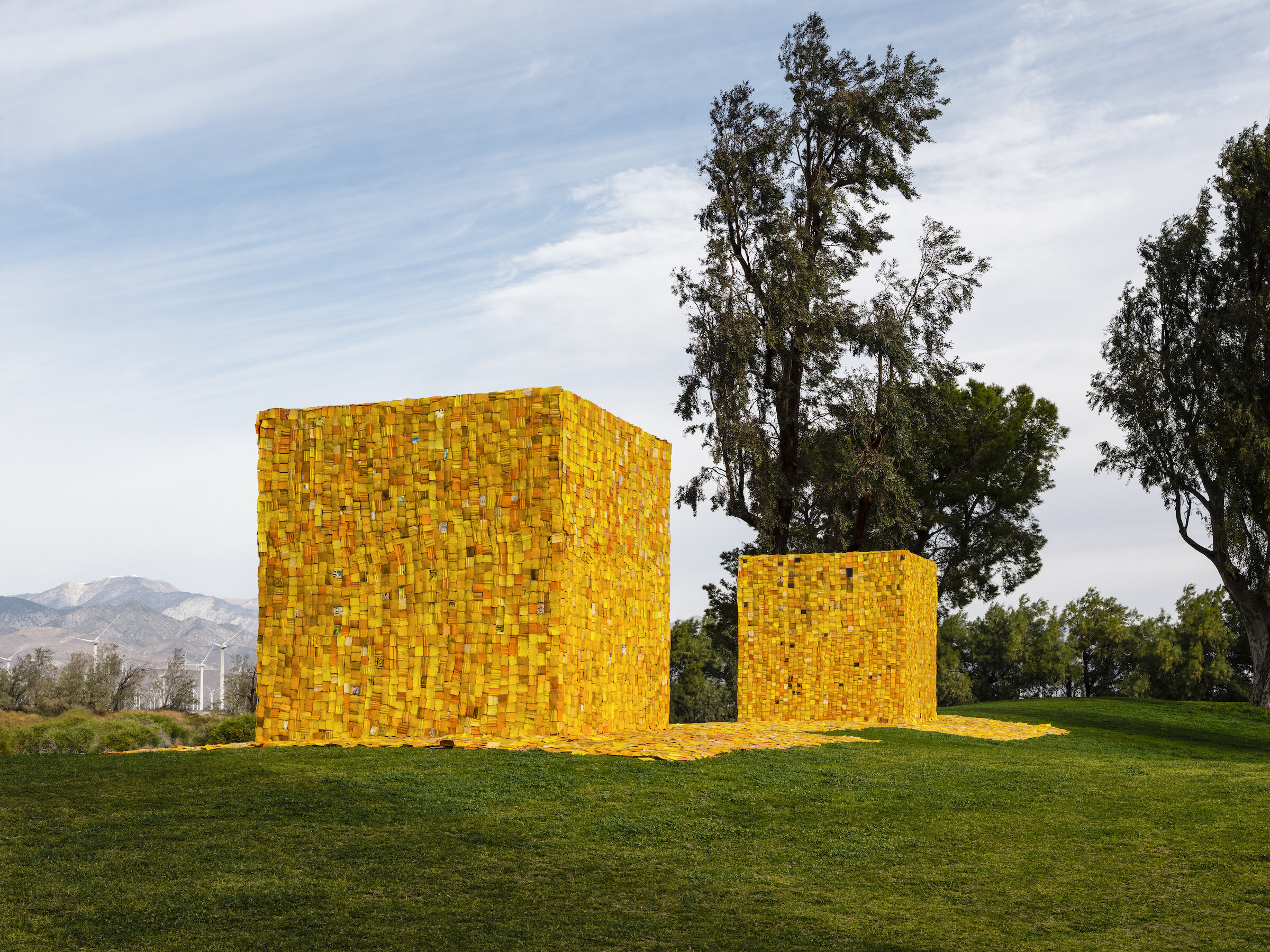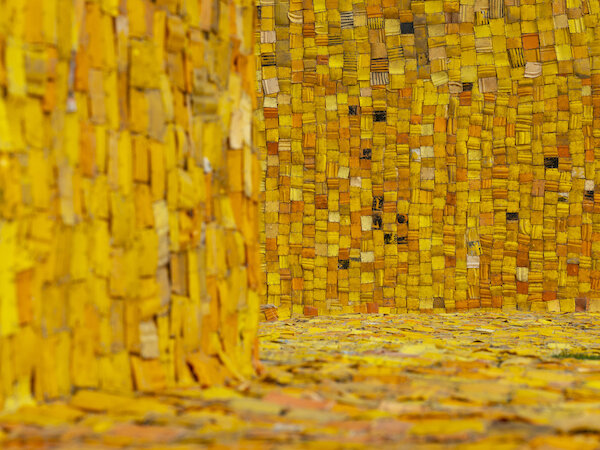Review: The Earth is Not Neutral, Desert X’s Land Art Brings a Call to Action
Desert X installation view of Nicholas Galanin, Never Forget. 2021. Photography by Lance Gerber. Courtesy the artist and Desert X. LANDBACK GoFundMe.
During the height of the Vietnam War, just weeks before Richard Nixon was elected President of the United States, the Land Art Movement emerged on the scene in October of 1968 with Robert Smithson’s exhibition in New York entitled ‘Earthworks.’
A response to growing discontent in an increasingly market-driven art world, Land Art was an effort to return art to its purest expression—one of wonder about the earth and our place in it. Pioneers such as Smithson and others including James Turrell, Nancy Holt, Richard Long, and Michael Heizer sought out remote landscapes untouched by humanity as the canvases for their expression, and untapped wells from which they’d source subject matter.
The movement’s manifesto was more self-evident than political. The idea that the earth has existed long before us and will continue to do so after we die is one that continues to intrigue. We are forever fascinated by our place in this world, the seeming timelessness of the earth, and the memories it holds. It seems there was no time more fitting for the birth of Land Art than in the midst of the counterculture movement of the ‘60s and ‘70s. As the legacy of land art continues to live on, a new exhibition at Desert X proves that its afterlives in the work of contemporary artists today, however, is perhaps a little less “neutral.”
The third iteration of Desert X, the international art biennial which takes place in the Coachella Valley every two years, officially opened last month and it appears the works have quite a lot to say. Curated by Artistic Director Neville Wakefield and co-curator César García-Alvarez, this year’s biennial, featuring thirteen artists from eight countries, features a handful of installations that bring contemporary issues of land use, environment and restitution to the forefront, demonstrating that art and activism quite seamlessly go hand in hand.
Desert X installation view of Serge Attukwei Clottey, The Wishing Well. 2021. Photography by Lance Gerber. Courtesy the artist and Desert X.
The most successful of the works challenge us to think in new ways about the interconnectedness of memory, land, and environment, with many bringing a call to action on how we can learn from our past to simply do better. Take Ghana-based artist Serge Attukwei Clottey’s The Wishing Well, for example. His work is a sculptural installation which features two large cubes cloaked in and connected by a yellow brick road of sorts: a golden tapestry made from linked together pieces of Kufor gallons, plastic jugs commonly used to transport water in Ghana. In highlighting issues of water scarcity, Attukwei Clottey’s work speaks to the journey many people around the world must make daily just to access clean water.
Desert X installation view of Serge Attukwei Clottey, The Wishing Well. 2021. Photography by Lance Gerber. Courtesy the artist and Desert X.
Kufor gallons, originally introduced by Europeans to transport cooking oil, not only serve as a reminder of a colonial past, but also in their new purpose of transporting water, reflect their transformation into emblems of survival and resilience. Although he repurposes objects specific to Africa, Attukwei Clottey engages in a conversation that translates across geographies world wide—one indeed relevant to the sun-baked desert of the Coachella Valley.
Desert X installation view of Nicholas Galanin, Never Forget. 2021. Photography by Lance Gerber. Courtesy the artist and Desert X. LANDBACK GoFundMe.
Also addressing the relationship between land and memory is Alaska-based artist Nicholas Galanin’s Never Forget, an installation of 45-ft tall letters spelling out “Indianland.” With this work, the Tlingit and Unangax artist demarcates the ancestral Cahuilla territory that is now Palm Springs. By appropriating the style of the original Hollywood sign, Galanin brings attention to the sign’s original history in promoting a white-only housing development in 1923. The artist’s installation not only reminds us of a past rooted in white settler mythology, but also as part of the land back movement, actively “asks land owners to participate in the work by transferring land titles and management to local indigenous communities.”
Driving along the Gene Autry Trail, one can’t help but be confronted by the billboards of artist Xaviera Simmons. Her statements relating to Black reparations and redistribution of wealth are both sharp and on-point.
While these three installations bring critical issues to the forefront, they appear nearly the same in person as they do in photos online. Two works, which bring less of a direct call to action, but are certainly more powerful when experienced in person are Zahrah Alghamdi’s What Lies Behind the Walls and Alicja Kwade’s ParaPivot (sempiternal clouds).
Desert X installation view of Zahrah Alghamdi, What Lies Behind the Walls. 2021. Photography by Lance Gerber. Courtesy the artist and Desert X.
Saudi artist Zahrah Alghamdi’s What Lies Behind the Walls is a monolithic wall composed of layered sediment, soils, dyes, rocks, and leather. Both colossal in size and seemingly able to topple over at a moment’s notice, Alghamdi’s 25 foot plus wall is impressive— particularly because upon closer examination, one sees it’s actually composed of soft, organic, earthy layers resembling bedding, insulation and maybe even carpet.
Exploring the idea of how memory and identity is often embedded in the earth and landscape, Alghamdi incorporates materials from various regions and through her layering, seamlessly binds different cultures together. Powerful in its subtlety, her wall reads to be a message of hope and connectedness rather than division.
Desert X installation view of Alicja Kwade, ParaPivot (sempiternal clouds). 2021. Photography by Lance Gerber. Courtesy the artist and Desert X.
Although perhaps the least outright political, Berlin-based artist Alicja Kwade’s ParaPivot (sempiternal clouds) is one not to be missed. Situated on a hilltop with an impressive view overlooking the desert, Kwade’s work presents us with a lesson in perspective. Her work, ParaPivot (sempiternal clouds) is composed of 200 million-year-old rock formations resting precariously atop a series of interconnected, larger-than-life metal frames. While the climb to the installation is certainly not for the faint of heart, her work forces you to consider notions of time and space, as well as your place in the environment around you and how it changes as you move through it.
Almost a direct reference to Michael Heizer’s Levitated Mass currently installed at LACMA, Kwade’s work builds on the precedent set forth by Heizer and takes it a few steps further. An expression of wonder about the natural world is taken to a cosmological level. Her installation appears like a constellation in the sky as you walk in and through these metal gates with rocks placed above you. It compels you to consider your place not only on earth but in relation to the ether as well.
These works aside, it is worth noting that this year’s biennial was a bit more disorganized than most. When the exhibition opened last month and we visited, nearly four of the thirteen works simply weren’t installed yet. The result of which led quite a few to drive around endlessly searching for works they just couldn’t find. These delays and the confusion surrounding them could very possibly reflect the challenges of pulling together an event of this size during a global pandemic, especially with so many international artists in tow. However, not the only snag this year, the biennial also received significant attention last month when one of its major exhibiting artists Judy Chicago decided to pull her work after community concerns were raised regarding the environmental impact of her forthcoming smoke installation on the Living Desert environment and wildlife.
On the bright side, a couple of additional works have been installed since our initial visit including Christopher Myers’ The Art of Taming Horses and the completion of Alicja Kwade’s ParaPivot (sempiternal clouds), which we were only able to view during its construction. Felipe Baeza’s Finding Home in My Own Flesh, however, still has yet to be installed. Despite such drawbacks, the exhibition is worth checking out with several of the artists engaging in a discussion of the critical issues of our time.
The biennial closes May 16. Timed tickets must be reserved for certain exhibits every Thursday through Sunday. More information can be found on the Desert X website.





